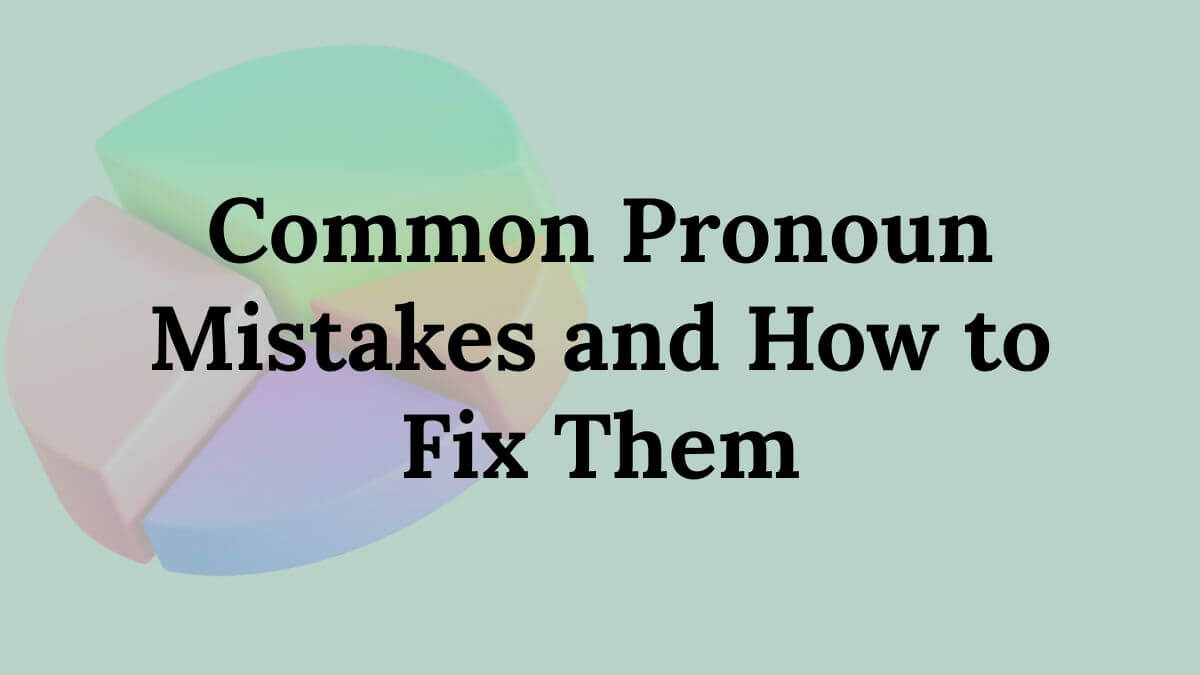Struggling with pronouns? Learn the most common pronoun mistakes English learners make and how to fix them with clear rules and helpful examples. Understanding pronouns is essential to mastering English grammar. Yet, even advanced learners often stumble over small—but—important mistakes. Whether it’s choosing between he or him, using who instead of whom, or mixing up their, there, and they’re, pronoun errors can confuse your message. In this blog post, we’ll explore the most common pronoun mistakes and provide simple, clear ways to correct them. Whether you’re a student, teacher, or English enthusiast, this guide will help you communicate more clearly and confidently.
Common Pronoun Mistakes
What Are Pronouns and Why Do They Matter?
Pronouns stand in for nouns, helping sentences flow smoothly without repeating the same words. Words like I, you, he, she, it, we, and they are common pronouns that make our speech and writing clearer and less repetitive.
Example:
Instead of saying, “Anna went to Anna’s house,” we say, “Anna went to her house.”
When used incorrectly, pronouns can make sentences unclear or grammatically wrong. Let’s look at the most frequent errors and how to avoid them. Common Pronoun Mistakes
1. Subject vs. Object Pronoun Confusion
A frequent pronoun error involves mixing up subject and object forms, like saying “Me went to the store” instead of “I went.”
What’s the Difference?
- Subject pronouns—like I, you, he, she, it, we, and they—take the lead in a sentence by acting.
- Object pronouns—such as me, you, him, her, it, us, and them—receive the action in a sentence.
Incorrect:
“She and I went to the store.”
“He gave the gift to her.”
Correct:
“She and I went to the store.”
“He gave the gift to her.”
Tip:
Remove the other person in the sentence to test it.
Would you say “I went to the store”? Of course not—so use “I.”
2. Ambiguous Pronoun Reference
Pronouns must point to a specific noun—when the reference is unclear, it can leave the reader guessing and confused. Common Pronoun Mistakes
Confusing:
“Tom told Jerry that he won the prize.”
(Who won? Tom or Jerry?)
Clear:
“Tom told Jerry, ‘You won the prize!’”
or
“Tom said that he had won the prize.”
Tip:
Always make sure your pronoun has a clear noun to refer to.
3. Mixing Up Possessive Pronouns
Possessive pronouns show ownership and must be used without apostrophes. Common Pronoun Mistakes
Common Mistakes:
- Confusing its and it’s
- Using your instead of you’re
- Mixing up their, they’re, and there
Correct Usage:
- It’s (possessive): The dog wagged its tail.
- It’s (contraction): It’s raining outside.
- Their (possessive): Their house is beautiful.
- They’re (they are): They’re coming soon.
- There (place): Put it over there.
Tip:
Read the sentence out loud using the full form of contractions. If it doesn’t sound right, check your spelling. Common Pronoun Mistakes
4. Incorrect Use of Reflexive Pronouns
Reflexive pronouns end in -self or -selves and refer back to the subject.
Wrong:
“John and I will handle it.”
“You can give it to me.”
Right:
“John and I will handle it.”
“You can give it to me.”
Tip:
Use reflexive pronouns only when the subject and object are the same person.
Example: I taught myself to code. Common Pronoun Mistakes
5. Who vs. Whom Confusion
This is one of the most dreaded grammar rules, even for native speakers. Common Pronoun Mistakes
Basic Rule
- Use who for the subject (does the action).
- Use whom for the object (receives the action).
Wrong:
“Who is coming to dinner?”
“Who did you give the book to?”
Correct:
“Who is coming to dinner?”
“To whom did you give the book?”
Tip:
Try replacing who or whom with he/she or him/her.
- If he/she fits, use who
- If it/her fits, use whom
6. Vague Pronouns in Long Sentences
In longer sentences, pronouns can get lost and become unclear.
Problematic:
“When Sarah met with Emily, she said her idea was better.”
(Who said what?)
Better:
“When Sarah met with Emily, Emily said her idea was better.”
Tip:
If there are two or more people/things in a sentence, consider repeating the noun for clarity.
7. Pronoun-Antecedent Agreement Errors
Pronouns must agree with the noun (antecedent) they refer to in number and gender.
Mistake:
“Everyone must bring their books.” (Everyone = singular; their = plural)
Correct:
“Everyone must bring his or her book.”
or
“All students must bring their books.”
Tip:
Use gender-neutral language when possible: Each person must bring a book.
8. Overusing Pronouns
Using too many pronouns in a paragraph can confuse the reader. Common Pronoun Mistakes
Confusing:
“He told him that he would help him with his homework.”
Clearer:
“James told Paul that he would help him with the homework.”
With proper nouns for better clarity and variety.
Read More:
Collective Nouns Explained Clearly with Real-Life Usage Tips
10 Simple English Dialogues for Beginners: Grow Your Speaking Skills
Conclusion
Understanding and avoiding these common pronoun mistakes is a big step toward writing and speaking fluent English. The more you practice, the more naturally these pronoun rules will come to you.. Always double-check your subject and object pronouns, ensure clarity, and stay aware of agreement between nouns and pronouns. By fixing these small errors, your communication becomes clearer, more professional, and easier to understand—whether you’re writing an essay, having a conversation, or teaching a grammar lesson. Common Pronoun Mistakes
